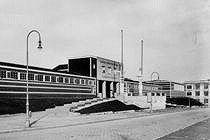
|
Amt Macht Stadt Erich Leischner and the Vienna Stadtbauamt Location: Architekturzentrum Wien - Old hall Exhibition: 16 June 1999 - 02 August 1999 Opening: Tuesday 15 June 1999, 7pm The Vienna Stadtbauamt as independent public municipal office was founded upon imperial decree in 1835. Grouping all the city offices involved in building and technology reflected the rise in municipal tasks, at a time, when numerous facilities, hitherto privately owned, were being transferred to communal administration. World War I While until World War I, when the population was booming and Karl Lueger was Vienna’s mayor, activities focused on the improvement of technical infrastructure and foresighted city planning, the downfall of the monarchy triggered far-reaching changes, which also fundamentally altered the Vienna Stadtbauamt. Red Vienna The communal politics propagated by the Red Vienna, which was read as the classic example of a "differentÓ type of politics by Social Democrat leaders, emphasized housing and public welfare. As a result, new construction needs arose which were catered to centrally by the architects of the Vienna Stadtbauamt. In particular at the beginning of the 20s, the civil servants employed in the architecture department busied themselves primarily with the planning of municipal residential buildings and housing estates. When in 1923, the number of such buildings to be built, stipulated by the Vienna municipality’s resolution in its 1st housing program shot up, assignments to large-scale construction projects began to include an increasing number of free-lance architects. Yet overall project handling remained in the hands of the Vienna Stadtbauamt. This housing program also saw the development of some central guidelines for the new apartments which became standards applicable to all municipal housing. By 1934, approximately one fourth of all municipal housing (i.e. more than 1500 apartments) had been put up by architects employed at the Vienna Stadtbauamt. Aside from housing, the large number of public welfare facilities, such as kindergartens, schools, swimming pools, and bathing grounds, in which Erich Leischner played a leading role as a planner, also merit special mention. Architectural Architectural continuity has developed at the Vienna Stadtbauamt in parallel Identity to the continuity of staff - leading to a distinct architectural vocabulary that extends beyond the familiar housing program to include all other communal building project categories. Finally, the superior role of the Stadtbauamt - especially of the architectural department - generated an architectural identity, an unmistakable architectural symbolism that enabled easy identification of projects related to the communal building program. The roots of this stylistic form, which cannot be attributed to modernity, cubism, constructivism, sezessionism, or historicism, yet adopts and integrates certain features of all these styles, can be found predominantly with the architects around Otto Wagner and urban development director, Heinrich Goldemund. Due to the focus of their training and their assistant work in Wagner’s atelier, the students of Otto Wagner were well versed in large-scale building projects and the challenges of urban planning. As a result, Wagner students were assigned plenty of communal building projects of varying size and some of them became permanently employed by the architectural department of the Vienna Stadtbauamt (Konstantin Peller, Gottlieb Michal, Engelbert Mang, Karl Ehn). Nazi regime With the invasion of the National Socialists, some conditions in the Vienna Stadtbauamt changed dramatically. Not that the staff was replaced, but the posts were reallocated among the staff employed. Both the expansion of the municipal area to "Gross-Wien and the war-time administrative and architectural reorientation brought about changes in the office’s constructional tasks. Housing projects - aside from a handful of cheerless estates - were more or less discontinued, and barracks, air-raid shelters, and temporary homes were built instead. Aside from German Reich architects, those responsible for planning these building projects - the overall volume being rather small - were the civil servant architects working at the Vienna Stadtbauamt. Aside from frequent exemption from military service, the permanent nature of employment at the municipality of Vienna also afforded the possibility to carry out planning tasks, even in an extremely tense situation. Reconstruction During reconstruction, the Vienna Stadtbauamt architects again significantly contributed to determining Vienna’s tectonic design following the ravages of war. A spectrum has resulted, spanning decades and differing ideological governments, which has clearly left its mark on Vienna’s city design. When during the reconstruction phase in 1949, the architectural department was closed and its activities were integrated into other departments (MA 19), the Vienna Stadtbauamt withdrew from its planning and execution role and centered its attention on consulting, thereby leaving more and more communal building projects to freelance architects. |
 |
|
© Martin Gerlach, Wiener Stadt- und Landesarchiv |
|
Current Preview Permanent Exhibition Amt Macht Stadt The Vienna Stadtbauamt Biography Press Release: Amt Macht Stadt |
| © Architekturzentrum Wien 2025 |
||



